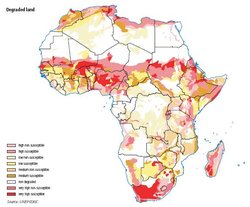Land degradation and desertification in Africa
Contents
- 1 IntroductionAfrica is endowed with enough land (Land resources in Africa) (Land degradation and desertification in Africa) to undertake small- and large-scale activities to strengthen household security, national development, transboundary cooperation and regional integration to transform trade, and create new opportunities for sustainable development which is sensitive to the environment and social and economic issues. There are, however, many threats and challenges which continue to undermine such progress, limiting its potential. These include pandemics such as HIV/AIDS, climate variability and change, extreme weather events such as drought and floods, ineffective land-use planning, land degradation and desertification, invasive alien species (Pests and invasive species in Africa) (IAS), limited or weak governance systems, corruption and greed, armed conflict and the attendant overexploitation of natural resources, and limited foreign direct investment (FDI). Limited domestic investment and wasted opportunities and loss of revenue due to leakage in sectors such as tourism are also important factors.
- 2 Land degradation and desertification
- 3 Further reading
IntroductionAfrica is endowed with enough land (Land resources in Africa) (Land degradation and desertification in Africa) to undertake small- and large-scale activities to strengthen household security, national development, transboundary cooperation and regional integration to transform trade, and create new opportunities for sustainable development which is sensitive to the environment and social and economic issues. There are, however, many threats and challenges which continue to undermine such progress, limiting its potential. These include pandemics such as HIV/AIDS, climate variability and change, extreme weather events such as drought and floods, ineffective land-use planning, land degradation and desertification, invasive alien species (Pests and invasive species in Africa) (IAS), limited or weak governance systems, corruption and greed, armed conflict and the attendant overexploitation of natural resources, and limited foreign direct investment (FDI). Limited domestic investment and wasted opportunities and loss of revenue due to leakage in sectors such as tourism are also important factors.
Land degradation and desertification
While irrigation could enhance food production (Agriculture and development in Africa), its inefficient application could also be a risk, particularly in terms of salinization. For example, about 10 percent of the world’s irrigated land has been damaged by salt, increasing the threats to food security. The build-up of salts in the soil lowers yields and can damage the land beyond economic repair. Salinization is reducing the world’s irrigated area by 1 to 2 percent every year, hitting hardest in the arid and semi-arid regions such as those common in Africa. In Senegal, for example, land (Land resources in Africa) has been cultivated and farmed without appropriate management of organic and mineral fertilizers, enhancing mineralization and soil organic matter loss.
A further threat to Africa realizing the full potential of its [[land (Land resources in Africa)] resources] is desertification. United Nations (UN) Secretary-General, Kofi Annan, has said that desertification undermines the fertility of the world’s land, with productivity losses reaching 50 percent in some areas. Today, a third of the Earth’s surface is threatened by desertification, which adds up to an area of over 4,000 million hectares (ha) of the planet. It not only contributes to food insecurity, famine and poverty, but may also fuel social, economic and political tensions that can cause migration, conflicts, further poverty and land degradation. It is estimated that the livelihoods (Human well-being and livelihoods in Africa) of more than 1,000 million people globally are at risk from desertification, which may eventually force 135 million people off their land. The problem appears to be most severe in Sub-Saharan Africa (SSA) and the Horn of Africa.
Further reading
- FAO, 2002. Besieged mountain ecosystems start to turn off the tap: reduced water flow threatens agriculture and food security around the globe. Food and Agriculture Organization of the United Nations.
- Tieszen, L. L.,Tappan, G. G. and Toure, A., 2004. Sequestration of carbon in soil organic matter in Senegal: an overview. Journal of Arid Environments. 59(3):409-25.
- UN, 2004. Livelihoods of Over One Billion People at Risk from Desertification, Secretary-General Says In Message On International Day. Message by Secretary-General Kofi Annan on the World Day to Combat Desertification and Drought, 17 June 2004. Press Release.
- UNCCD, 2004. FAQ about UNCCD. United Nations Convention to Combat Desertification.
- UNEP, 2006. Africa Environment Outlook 2
|
|
| Disclaimer: This article is taken wholly from, or contains information that was originally published by, the United Nations Environment Programme. Topic editors and authors for the Encyclopedia of Earth may have edited its content or added new information. The use of information from the United Nations Environment Programme should not be construed as support for or endorsement by that organization for any new information added by EoE personnel, or for any editing of the original content. |
